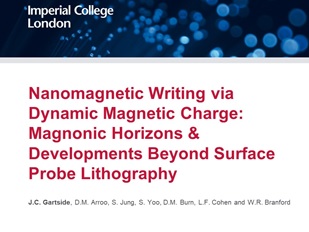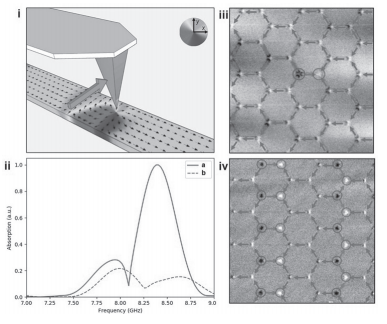
Nanomagnetic Writing via Dynamic Magnetic Charge: Magnonic Horizons & Developments Beyond Surface Probe Lithography
J.C. Gartside, D.M. Arroo, S. Jung, S. Yoo, D.M. Burn, L.F. Cohen and W.R. Branford
International Conference on Magnetism San Francisco Jul 2018
Much of the intrigue and utility of nanomagnetic systems arises from the properties of specific system-wide magnetic configurations, or microstates. From practical applications such as data storage to microstates of fundamental physical and statistical interest such as ground states1,2 or metastable excitations3,4, the ability to prepare systems in any given microstate is of crucial importance. Historically, microstate preparation methods have been somewhat limited – relying on globally-applied or stripline-generated fields and thermalisation protocols to access a limited range of states. Groups have recently demonstrated that the dynamic magnetic charge of a scanning MFM tip may be used to write all conceivable microstates5,6, but requires that the sample is situated within expensive and cumbersome SPM hardware.
We present developments and applications of the dynamic magnetic-charge writing method Topological Defect-Driven Magnetic Writing (TMW)6, outlining a fully solid-state and current-addressable SPM-free solution replacing the MFM tip with alternative magnetic charge sources. This improved technique is leveraged to realise novel reconfigurable magnonic circuit elements, implemented within strongly-interacting nanomagnetic networks.

Figure 1: i) Schematic of dynamic magnetic charge writing process. ii) Spin-wave spectra for hexagonal NiFe nanoarrays prepared in two dynamic magnetic charge written states (a,b), exhibiting peaksuppression via microstate control. iii) MFM image of single pair of monopole excitations in hexagonal NiFe magnetic nanoarray, realised via dynamic magnetic charge writing. iv) MFM image of repeating columns of monopole excitations or monopole ladders, realised via dynamic magnetic charge writing.
- [1] Morgan, J. P. et al. Nature Physics 7.1 (2011): 75.
- [2] Perrin, Yann, et al. Nature 540.7633 (2016): 410-413.
- [3] Anghinolfi, L., et al. Nature Comms. 6 (2015). 231 3 Ladak, S. et al. Nature Physics 6.5 (2010): 359-363.
- [4] Mengotti, E. et al. Nature Physics 7.1 (2011): 68.
- [5] Wang, Yong-Lei, et al. Science 352.6288 (2016): 962-966.
- [6] Gartside, J. C., et al. Nature Nanotechnology 13 (2017): 53-58.